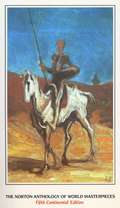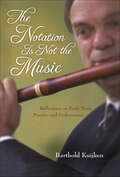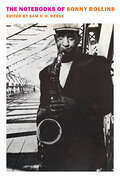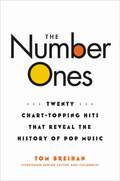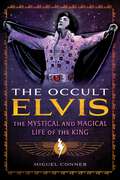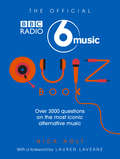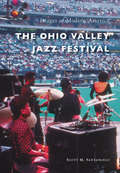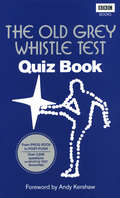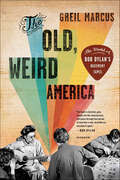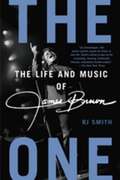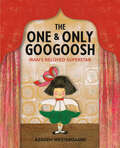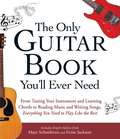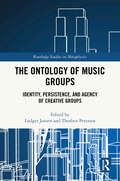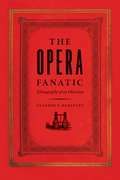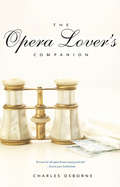- Table View
- List View
The Norton Anthology of World Masterpieces (Fifth Continental Edition)
by Maynard MackA selection of Western literature containing only works written originally in the ancient and modern foreign languages.
The Notation Is Not the Music: Reflections on Early Music Practice and Performance (Publications of the Early Music Institute)
by Barthold KuijkenWritten by a leading authority and artist of the historical transverse flute, The Notation Is Not the Music offers invaluable insight into the issues of historically informed performance and the parameters—and limitations—of notation-dependent performance. As Barthold Kuijken illustrates, performers of historical music should consider what is written on the page as a mere steppingstone for performance. Only by continual examination and reexamination of the sources to discover original intent can an early music practitioner come close to authentic performance.
The Notebooks of Sonny Rollins
by Sonny RollinsAn illuminating selection of writings on a wide variety of topics—everything from technique, music theory, and daily routine to spirituality and systemic racism—from the personal journals of Sonny Rollins, master of the tenor saxophone and &“jazz&’s greatest living improviser&” (The New York Times).Sonny Rollins is one of the towering masters of American music, a virtuoso of the saxophone, and an unequaled improviser whose live performances are legendary and who has reshaped modern jazz time and time again over the course of a career lasting more than sixty years. A turning point in that legendary career came in 1959, when Rollins stepped back from performing and recording to begin a new regime of musical exploration, which saw him practicing for hours, sometimes all through the night, on the Williamsburg Bridge. This was also the moment when he started the notebook that would become a trusted companion in years to come—not a diary so much as a place to ponder art and life and his own search for meaning in words and in images.At once quotidian and aphoristic, the notebooks mingle lists of chores and rehearsal routines with ruminations on nightclub culture, racism, and the conundrums of the inner life. And always there is the music—questions of embouchure, fingering, and technique; of harmony and dissonance; of his own and others&’ art and the art of jazz. &“Any definition,&” Rollins insists, &“which seeks to separate Johann Sebastian Bach from Miles Davis is defeating its own purpose of clarification. . . .The Musings of Miles is then the Bouncing of Bach both played against each other.&” Edited and introduced by the critic and jazz scholar Sam V.H. Reese, The Notebooks of Sonny Rollins provides an unequaled glimpse into the mind and workshop of a musical titan, as well as a wealth of insight and inspiration to readers.
The Number Ones: Twenty Chart-Topping Hits That Reveal the History of Pop Music
by Tom BreihanBeloved music critic Tom Breihan's fascinating narrative of the history of popular music through the lens of game-changing #1 singles from the Billboard Hot 100. When Tom Breihan launched his Stereogum column in early 2018, &“The Number Ones&”—a space in which he has been writing about every #1 hit in the history of the Billboard Hot 100, in chronological order—he figured he&’d post capsule-size reviews for each song. But there was so much more to uncover. The column has taken on a life of its own, sparking online debate and occasional death threats. The Billboard Hot 100 began in 1958, and after four years of posting the column, Breihan is still in the early aughts. But readers no longer have to wait for his brilliant synthesis of what the history of #1s has meant to music and our culture. In The Number Ones, Breihan writes about twenty pivotal #1s throughout chart history, revealing a remarkably fluid and connected story of music that is as entertaining as it is enlightening.The Numbers Ones features the greatest pop artists of all time, from the Brill Building songwriters to the Beatles and the Beach Boys; from Motown to Michael Jackson, Prince, and Mariah Carey; and from the digital revolution to the K-pop system. Breihan also ponders great artists who have never hit the top spot, like Bob Dylan, Bruce Springsteen, and James Brown. Breihan illuminates what makes indelible ear candy across the decades—including dance crazes, recording innovations, television phenomena, disco, AOR, MTV, rap, compact discs, mp3s, social media, memes, and much more—leaving readers to wonder what could possibly happen next.
The Oboe: An Outline of Its History, Development, and Construction
by Philip BateMr. Bates covers the known history of the oboe since its emergence in the late seventeenth century and its development from the shawm. He also makes comparisons with previously known double-reed instruments and varying types of oboes. The accoustical properties of the oboe are discussed, from the viewpoint of classical acoustics…There are chapters on traditional and modern methods of manufacture and materials; biographies of famous players; and an extended bibliography.
The Occult Elvis: The Mystical and Magical Life of the King
by Miguel Conner&“A lively new book.&” —The Guardian• Draws on firsthand accounts from Elvis&’s wife, Priscilla, his friends and family, the Memphis Mafia, and his spiritual advisors• Looks at key teachers who influenced him, including Yogananda, H. P. Blavatsky, and Manly P. Hall• Examines Elvis&’s efforts as a natural healer, the significance of his UFO encounters, and his telekinetic, psychic, and astral traveling abilitiesElvis Presley, the most successful solo artist in history and an emblematic cultural figure of the Western world, has been widely perceived as a conservative Southern Christian. However, the truth about the man has been missed.Writer and researcher Miguel Conner reveals how Elvis was a profound mystic, occultist, and shaman. Beginning with the unusual circumstances of his birth—and his stillborn twin brother—Conner traces the diverse thread of mysticism that runs through Elvis Presley&’s life, drawing on firsthand accounts from the people closest to him, including his wife, Priscilla, the Memphis Mafia, and his spiritual advisors. He shows how Elvis studied seminal 19th- and 20th-century occultists, including H. P. Blavatsky, Manly P. Hall, G. I. Gurdjieff, and P. D. Ouspensky, and was a devotee of Indian yogi Paramahansa Yogananda. Conner argues that Elvis was well-versed in the esoteric practices of sex magic, meditation, astrology, and numerology and had a deep familiarity with Kabbalah, Gnosticism, Theosophy, and Eastern traditions. He also reveals how Elvis was a natural healer, telekinetic, psychic, and astral traveler who had significant mystical experiences and UFO encounters.Looking at the conspiratorial and paranormal aspects of Elvis&’s life, the author explores the "Elvis visitations" that have occurred since the King&’s death and the general high weirdness of his life. As Conner convincingly argues, Elvis was not just a one-of-a-kind rock-and-roller. He was the greatest magician America ever produced.
The Official Radio 6 Music Quiz Book
by Nick HoltBBC Radio 6 Music is the place for alternative music – and this is the quiz for its fans. From indie pop and iconic rock to trip hop, electronica and dance, these questions will test your knowledge of the last 60 years of floor-fillers, cult classics and the best B-sides to the limit. Including dedicated quizzes on your favourite 6 Music shows, like Lauren Laverne's People's Playlist, Guy Garvey's Finest Hour, Jarvis Cocker's Sunday Service and more, find out how much you can really call yourself the king of rock n' roll.
The Ohio Valley Jazz Festival (Images of Modern America)
by Scott M. SantangeloCincinnati, Ohio, might have seemed like an unlikely choice to host the nation's largest annual R&B concert, but thanks to local promoter Dino Santangelo, the Ohio Valley Jazz Festival would become the "Granddaddy of Them All." The first festival was held in 1962 at the Carthage Fairgrounds, but the event would continue to grow--moving to Crosley Field in 1964 and then Riverfront Stadium in 1971--to become the nation's biggest two-day stadium concert. The Ohio Valley Jazz Festival would eventually feature the most popular R&B artists of the day and draw audiences from as far as 500 miles away. The festival pioneered stadium concert production, generated millions for the regional economy, and eased the Greater Cincinnati community's difficult cultural transition throughout the turbulent 1960s and 1970s.
The Old Grey Whistle Test Quiz Book
by Mark PaytressBob Dylan. Tom Waits. Blondie. The Ramones. REM. The Who. Fleetwood Mac. Led Zeppelin. The list goes on and on.The Old Grey Whistle Test has played host to some of the biggest names in music and has assumed its rightful place at the pinnacle of rock history - but how much of a fan are you?Do you know your Bowie backlist? Could your knowledge of Lennon long-players stand up to scrutiny? And can you tell your glam rock from your hair metal? This collection delves deep into the Whistle Test archives to pose over 2,500 quiz questions on your favourite artists, from global megastars to obscure one-time guests on the show. Play in teams or test your own knowledge on questions covering a whole range of musical puzzles, from lost albums and banned songs to classic solos, one-hit wonders and more.
The Old, Weird America: The World of Bob Dylan's Basement Tapes
by Greil MarcusPreviously published as Invisible Republic and already considered a classic of modern American cultural criticism, this is an updated edition of Greil Marcus's acclaimed book on the secret music made by Bob Dylan and the Band in 1967, which introduced a phrase that has become part of the culture: "the old, weird America."Marcus's widely acclaimed book is about the secret music (the so-called "Basement Tapes") made by Bob Dylan and the Band while in seclusion in Woodstock, New York, in 1967 a folksy yet funky, furious yet hilarious music that remains as seductive and baffling today as it was more than half a century ago.As Mark Sinker observed in The Wire: "Marcus's contention is that there can be found in American folk a community as deep, as electric, as perverse, and as conflicted as all America, and that the songs Dylan recorded out of the public eye, in a basement in Woodstock, are where that community as a whole gets to speak." But the country mapped out in this book, as Bruce Shapiro wrote in The Nation, "is not Woody Guthrie's land for made for you and me . . . It's what Marcus calls 'the old, weird America.'" This odd terrain, this strange yet familiar backdrop to our common cultural history--which Luc Sante (in New York magazine) termed the "playground of God, Satan, tricksters, Puritans, confidence men, illuminati, braggarts, preachers, anonymous poets of all stripes"--is the territory that Marcus has discovered in Dylan's most mysterious music. And his analysis of that territory "reads like a thriller" (Ken Tucker, Entertainment Weekly) and exhibits "a mad, sparkling brilliance" (David Remnick, The New Yorker) throughout. This special edition includes a new introduction, an updated discography, and never-before-seen photographs of the legendary recording sessions.“This book is terminal, goes deeply into the subconscious and plows through that period of time like a rake. Greil Marcus has done it again.” -- Bob Dylan
The One
by Rj SmithThe definitive biography of James Brown, the Godfather of Soul, with fascinating findings on his life as a Civil Rights activist, an entrepreneur, and the most innovative musician of our time Playing 350 shows a year at his peak, with more than forty Billboard hits, James Brown was a dazzling showman who transformed American music. His life offstage was just as vibrant, and until now no biographer has delivered a complete profile. The One draws on interviews with more than 100 people who knew Brown personally or played with him professionally. Using these sources, award-winning writer RJ Smith draws a portrait of a man whose twisted and amazing life helps us to understand the music he made. The One delves deeply into the story of a man who was raised in abject-almost medieval-poverty in the segregated South but grew up to earn (and lose) several fortunes. Covering everything from Brown's unconventional childhood (his aunt ran a bordello), to his role in the Black Power movement, which used "Say It Loud (I'm Black and Proud)" as its anthem, to his high-profile friendships, to his complicated family life, Smith's meticulous research and sparkling prose blend biography with a cultural history of a pivotal era. At the heart of The One is Brown's musical genius. He had crucial influence as an artist during at least three decades; he inspires pity, awe, and revulsion. As Smith traces the legend's reinvention of funk, soul, R&B, and pop, he gives this history a melody all its own.
The One & Only Googoosh: Iran's Beloved Superstar
by Azadeh WestergaardA celebration of one of Iran&’s most iconic musical artists.The legendary Iranian singer and actress Googoosh (born Faegheh Atashin) made her stage debut at age two while performing alongside her acrobat father. By the time she reached adulthood, she was widely considered to be Iran's first superstar. Googoosh was in the prime of her career and on the brink of international stardom, but after the 1979 Iranian Revolution, she was silenced and disappeared from public life for over twenty years. However, her fans did not forget her. And as they sought refuge around the globe, they found ways to keep her music alive.Azadeh Westergaard has crafted an unforgettable love letter to the home she once knew in Iran and to the woman who was and still is a cultural icon—a dazzling performer known as the one and only Googoosh.
The One: The Life and Music of James Brown
by Rj SmithThe definitive biography of James Brown, the Godfather of Soul, with fascinating findings on his life as a Civil Rights activist, an entrepreneur, and the most innovative musician of our time Playing 350 shows a year at his peak, with more than forty Billboard hits, James Brown was a dazzling showman who transformed American music. His life offstage was just as vibrant, and until now no biographer has delivered a complete profile. The One draws on interviews with more than 100 people who knew Brown personally or played with him professionally. Using these sources, award-winning writer RJ Smith draws a portrait of a man whose twisted and amazing life helps us to understand the music he made.The One delves deeply into the story of a man who was raised in abject-almost medieval-poverty in the segregated South but grew up to earn (and lose) several fortunes. Covering everything from Brown's unconventional childhood (his aunt ran a bordello), to his role in the Black Power movement, which used "Say It Loud (I'm Black and Proud)" as its anthem, to his high-profile friendships, to his complicated family life, Smith's meticulous research and sparkling prose blend biography with a cultural history of a pivotal era.At the heart of The One is Brown's musical genius. He had crucial influence as an artist during at least three decades; he inspires pity, awe, and revulsion. As Smith traces the legend's reinvention of funk, soul, R&B, and pop, he gives this history a melody all its own.
The Only Basic Guitar Instruction Book You'll Ever Need
by Jack Wilkins Peter RubieNarratives on famous guitarists and the extra details on guitar history are fine, but that's not what readers need or want when they are eager to master their new guitar. The Only Basic Guitar Instruction Book You'll Ever Need jumps straight into teaching beginners note reading, hand positions, and other essentials, including how to hold their guitar properly and pick notes with their right hand; progress beyond the basics to integrate playing with both hands; shift positions, play harmony, and understand chord structures; and more! Although learning the guitar can seem intimidating, this easy-to-use, step-by-step guide is simple enough even for novices, who can start picking simple tunes and learn to play chords in no time.
The Only Basic Guitar Instruction Book You'll Ever Need: Learn to Play--from Tuning Up to Strumming Your First Chords
by Jack WilkinsA Simon & Schuster eBook. Simon & Schuster has a great book for every reader.
The Only Basic Guitar Instruction Book You'll Ever Need: Learn to Play-from Tuning Up to Strumming Your First Chords
by Jack Wilkins Peter RubieNarratives on famous guitarists and the extra details on guitar history are fine, but that's not what readers need or want when they are eager to master their new guitar. The Only Basic Guitar Instruction Book You'll Ever Need jumps straight into teaching beginners note reading, hand positions, and other essentials, including how to: Hold their guitar properly and pick notes with their right hand Progress beyond the basics to integrate playing with both hands Shift positions, play harmony, and understand chord structures Although learning the guitar can seem intimidating, this easy-to-use, step-by-step guide is simple enough even for novices, who can start picking simple tunes and learn to play chords in no time.
The Only Basic Piano Instruction Book You'll Ever Need
by Brooke HalpinLots of piano books offer either in-depth analysis or quick gimmicks that don't really teach music theory. But The Only Basic Piano Instruction Book You'll Ever Need is different. For students who want to learn the basics and dive right into playing, this book skips all the unnecessary trivia on the history of pianos and avoids lengthy digressions on classical and contemporary musicians. Instead, it focuses specifically on piano instruction and includes the basics of musical terms, definitions, note-reading structure, and time and key signatures; the foundations for chords and more complicated note constructs; exercises and sample pieces of music that range from playing simple notes to combining harmony and melody; and much more! Perfect even for those starting from scratch, The Only Basic Piano Book You'll Ever Need makes learning to play a cinch.
The Only Basic Piano Instruction Book You'll Ever Need
by Brooke HalpinLots of piano books offer either in-depth analysis or quick gimmicks that don't really teach music theory. But The Only Basic Piano Instruction Book You'll Ever Need is different. For students who want to learn the basics and dive right into playing, this book skips all the unnecessary trivia on the history of pianos and avoids lengthy digressions on classical and contemporary musicians. Instead, it focuses specifically on piano instruction and includes the basics of musical terms, definitions, note-reading structure, and time and key signatures; the foundations for chords and more complicated note constructs; exercises and sample pieces of music that range from playing simple notes to combining harmony and melody; and much more! Perfect even for those starting from scratch, The Only Basic Piano Book You'll Ever Need makes learning to play a cinch.
The Only Basic Piano Instruction Book You'll Ever Need: Learn to Play--from Reading Your First Notes to Constructing Complex Cords
by Brooke HalpinA Simon & Schuster eBook. Simon & Schuster has a great book for every reader.
The Only Book You'll Ever Need: From Tuning Your Instrument And Learning Chords To Reading Music And Writing Songs, Everything You Need To Play Like The Best (The\only Book You'll Ever Need Ser.)
by Ernie JacksonThese handy, accessible books provides literally all the information you need to know to gain a new hobby or understand a difficult topic. "Guitar" makes learning how to play an acoustic or electric guitar easy and will serve as the perfect introduction to this popular instrument. This title covers everything you need to know: how to play your first songs, reading music and tablature, mastering genre styles, and much, much more. With clear step-by-step instructions, diagrams and practice tips, this practical manual will have readers playing chords and songs in no time.
The Only Guitar Book You'll Ever Need
by Marc Schonbrun Ernie JacksonYour one-stop guide to learning guitar! Whether you've been strumming the guitar since you were a kid or are just starting out, The Only Guitar Book You'll Ever Need will help you take your music to the next level. Filled with clear, step-by-step instructions and tons of professional tips, this guide teaches you everything you need to know about playing a guitar, from buying the right model to performing all your favorite songs. This book also includes helpful information on: Reading music Tuning any guitar Mastering scales and chords Alternating tuning, harmonics, and slide playing Equipment, such as straps, amplifiers, strings, and pedals A complete introduction to one of the world's most popular instruments, The Only Guitar Book You'll Ever Need shows you how to master the guitar in no time!
The Only Guitar Book You'll Ever Need: From Tuning Your Instrument and Learning Chords to Reading Music and Writing Songs, Everything You Need to Play like the Best
by Marc SchonbrunYour one-stop guide to learning guitar!Whether you've been strumming the guitar since you were a kid or are just starting out, The Only Guitar Book You'll Ever Need will help you take your music to the next level. Filled with clear, step-by-step instructions and tons of professional tips, this guide teaches you everything you need to know about playing a guitar, from buying the right model to performing all your favorite songs. This book also includes helpful information on:Reading musicTuning any guitarMastering scales and chordsAlternating tuning, harmonics, and slide playingEquipment, such as straps, amplifiers, strings, and pedalsA complete introduction to one of the world's most popular instruments, The Only Guitar Book You'll Ever Need shows you how to master the guitar in no time!
The Ontology of Music Groups: Identity, Persistence, and Agency of Creative Groups (Routledge Studies in Metaphysics)
by Ludger Jansen Thorben PetersenThis volume examines the ontology of music groups. It connects two fascinating areas of philosophical research: the ontology of social groups and the philosophy of music.Interest in questions about the nature of music groups is growing. Since people are widely familiar with music groups, the topic is particularly well-suited for introducing issues in social ontology. Being comparably small-scale and temporary, music groups also provide an excellent case study for those who think that social groups are analyzed best by considering small groups. The present volume provides a comprehensive overview of the topic and seeks to establish the ontology of music groups as a distinct field of philosophical research. The chapters, written by leading scholars working on social ontology, revolve around four core themes: The identity of music groups Variations between different kinds of music groups The persistence and longevity of (different kinds of) music groups Various characteristics of music groups, including their rational and emotional aspects, as well as their creative abilities The contributors consider these themes across a wide range of music groups, including popular music groups, rock bands, alternative acts, hip hop crews, choirs and classical orchestras.The Ontology of Music Groups will appeal to scholars and advanced students working in social ontology, metaphysics, and the philosophy of music.
The Opera Fanatic: Ethnography of an Obsession
by Claudio E. BenzecryThough some dismiss opera as old-fashioned, it shows no sign of disappearing from the world’s stage. So why do audiences continue to flock to it? Given its association with wealth, one might imagine that opera tickets function as a status symbol. But while a desire to hobnob with the upper crust might motivate the occasional operagoer, for hardcore fans the real answer, according to The Opera Fanatic, is passion—they do it for love. Opera lovers are an intense lot, Claudio E. Benzecry discovers in his look at the fanatics who haunt the legendary Colón Opera House in Buenos Aires, a key site for opera’s globalization. Listening to the fans and their stories, Benzecry hears of two-hundred-mile trips for performances and nightlong camp-outs for tickets, while others testify to a particular opera’s power to move them—whether to song or to tears—no matter how many times they have seen it before. Drawing on his insightful analysis of these acts of love, Benzecry proposes new ways of thinking about people’s relationship to art and shows how, far from merely enhancing aspects of everyday life, art allows us to transcend it.
The Opera Lover's Companion
by Charles OsborneThis engaging guide to the 175 most popular operas will enhance the experience of every opera lover. Written by a well-known authority, the book consists of entries that set each opera within the context of its composer's career, outline the plot, discuss the music, and give relevant background information on the libretto, the staging, and the most famous and influential interpreters of the principal roles. In addition, the entries recount details of the first performance and subsequent performance history and provide guidance on the relative quality of available recordings. Aimed at opera lovers and committed newcomers rather than specialists, The Opera-Lover's Companion does not set out to cover every opera but only those most frequently encountered in opera houses or on recordings. Although the book is dominated by the five great opera composers-Mozart, Verdi, Wagner, Puccini, and Strauss-fifty-eight other composers are also represented. It is always more pleasurable to go to the opera with a knowledgeable and experienced companion. If you can't, you'll want to take this book.
